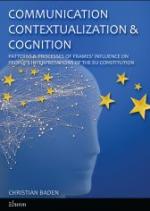Citation:

Abstract:
Frames affect the meaning of information by embedding it within selective, coherent, and purposefully chosen context. Over the last decades, researchers have ventured to explore how the provision of specific frames affects and alters people's interpretations and evaluations. They have derived a wide variety of approaches to the study of frames, and have advanced complementary as well as competing theories of how the well-known framing effect can be explained. A related aspect that has largely eluded scientific attention so far, however, is how frame-induced variations of derived meaning relate to the discursive construction, as well as the cognitive acquisition and elaboration of meaning required to make sense of a complex reality. This thesis addresses this question. It develops and empirically tests a perspective on framing that views frames as embedded within larger semantic networks. In the theoretical second chapter, frames are conceptualized as locally coherent patterns within the propositional structure of discourse on the one hand, and cognition on the other. Linking this view to the dominant perspectives on framing in scientific discourse, this approach achieves four main objectives: First, it provides a conceptualization of frames that relates to both linguistic and psychological (notably: schema-based) theories of meaning. It hence allows reformulating past theorizing and findings about frames within a common conceptual framework – the semantic network. Second, as a consequence, it provides a platform upon which the competing process models advanced within the study of framing effects can be integrated into a single, multi-stage cognitive process. Third, based on this integrated model, predictions can be made about the cognitive reconstruction of frames from communication, enabling people to embed information meaningfully into coherent context. Frames are thus understood as structures facilitating and directing the acquisition of complex knowledge. Finally, the developed conceptualization allows a much more detailed and precise operationalization of frames than common holistic approaches, and enables an inductive identification of frames. The various propositions and predictions derived from the theoretical model are empirically tested in the subsequent chapters. Chapter III introduces the case chosen for data collection: This study captures the propositions and frames advanced in relation to the EU Constitution during the referendum campaign in the Netherlands, and juxtaposes these with the beliefs and cognitive frames formed by Dutch voters. The EU Constitution has been selected as a salient but novel concern which related to scarce but well-organized prior knowledge among the Dutch electorate. It therefore provides a suitable case for studying the acquisition and integration of knowledge from public communication. In chapter IV, the core theoretical propositions regarding the cognitive mechanisms of frame processing are tested experimentally. For this purpose, subjects were exposed to framed messages varying with regard to their semantic context, focal issue, and evaluative drift. Subsequently, participants‘ spontaneous associations with the focal concept were recorded. In line with the theoretical model, results indicate that framing is best understood as a predominantly semantic effect, wherein contextual cues raise different schematic knowledge for information processing. The evaluative shifts often noted in the study of framing effects derive from the knowledge tapped for processing and are not directly affected by the provided frame itself. Chapter V focuses on the structure of frames rendered available to Dutch voters, analyzing the contents of mass media discourse and the political parties' referendum campaigns. Based on the recorded propositional structures, several expectations about the composition and alignment of frames within discourse are tested. Results show that frames relate to one another within the narrative and argumentative structure of persuasive accounts, while the frames used in news reporting do not necessarily form coherent patterns. However, consonance between different sources' news frames was markedly higher than within political discourse. Turning toward cognitive representations, chapter VI assesses the belief structures formed by Dutch voters with regard to the EU Constitution. While the importance of frame structures in crafting coherence within accounts is further corroborated, the identified cognitive frames deviate in systematic ways from those provided in public discourse. Notably, people show considerable discretion of which available frames they accept and include into their accounts. Voters‘ narratives rarely followed those templates advocated in public, but combined considerations taken from various sources, using frames to weave connections between the selected shards of knowledge. In order to further substantiate the differences and similarities detected between communicated and acquired frames, chapter VII performs a comparative analysis of the semantic networks constructed from either source. It finds that television and political sources were most influential for the formation of people's understandings, followed by broadsheet newspapers. Moreover, results show that people combined and reconciled frames with opposing evaluative drift, advanced by rival campaigning actors. People were notably more reliant on communicated frames regarding novel, unobtrusive, and current issues, while prior knowledge mostly overrode provided frames on familiar, long standing issues. In summary, this thesis argues that frames are integral to the formation of coherent accounts in discourse and cognition. It advocates a wide view that focuses not so much on isolated, single frames and their effects, but on the interplay of various interrelated frames in both communication and cognition. This study provides a theoretical framework for investigating how frames create coherent meaning from disparate propositions. Simultaneously, it considers how multiple frames relate to one another within narrative and persuasive communication. Thus addressing structures both beyond and within the frame, it provides a methodological approach that is well-tailored to translate the theoretical concerns into discernible measures. The semantic network based view on frames advanced in this study hence furthers our understanding of frames in at least three respects: First, it helps disentangling several concepts that have been confounded in the literature, adding precision to the theoretical debate. Second, it supports a methodological framework capable of translating the gain in theoretical precision into well-differentiated measures. Finally, it contextualizes frames, relating these to other important concepts in the study of communication and information processing. The present dissertation thus underscores the relevance of frames, which rests to a large degree in their contribution to the creation of meaning from information.

